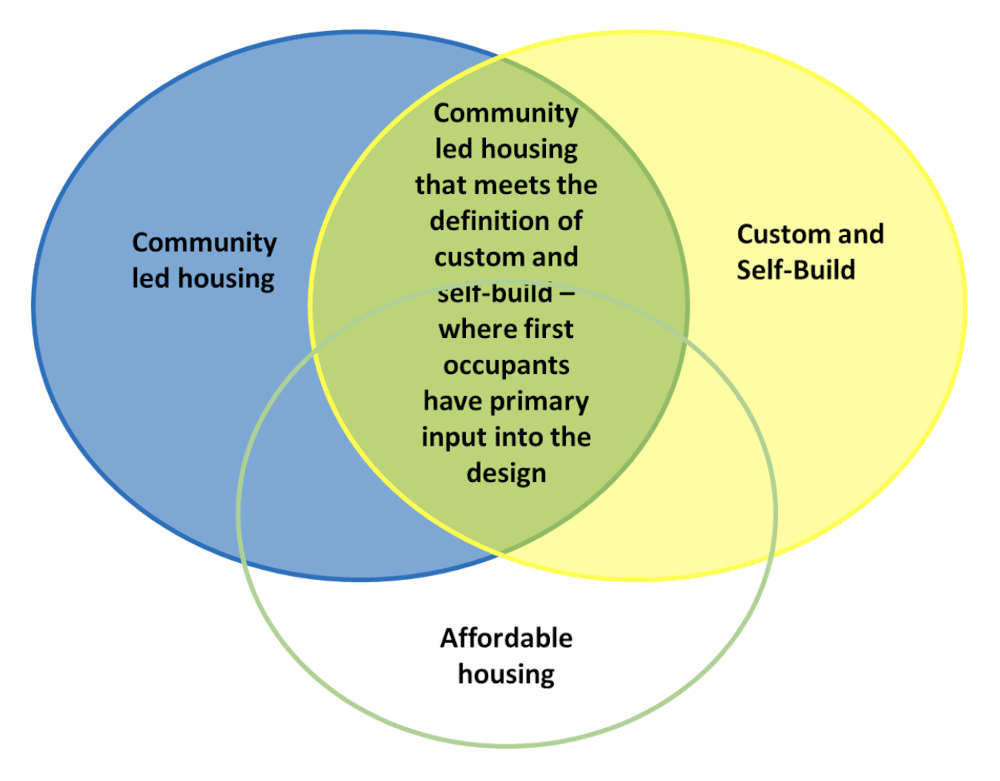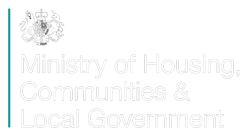AN: 1.3 – Community Led Housing
Summary
Community led housing is a movement of people working together to develop new homes or refurbish existing homes, often as affordable housing (either in the official or more general sense) to buy or rent for those on lower incomes. Some forms of community led housing meet the definition of custom and self-build – where the first occupants have had primary input into the final design of the homes. However, not all forms of community led housing qualify as custom and self-build, and vice versa.
This advice note provides an overview of community led housing, summarises the opportunity of community led housing for Local Authorities and clarifies where community led housing meets the definition of custom and self-build.
Contents
What is community led housing?
Tenures and development models
Data and location of groups and projects
Community led housing and custom and self-build
Where community led housing projects meet the definition of custom and self-build
Where community led housing projects clearly do not meet the definition
What is the opportunity of community led housing for local authorities?
What support is available?
How Local Authorities (LPAs) can help
What is community led housing?
Community led housing is a growing movement where local people come together to develop new or refurbish existing housing to meet local needs, often Affordable homes. There are several different types of community led housing, including (but not limited to):
- Community Land Trusts (CLT) – democratic, non-profit organisations set up and run by local people to develop and manage homes and other assets that their community wants and needs. The CLT acts as a long-term steward of the homes, ensuring that they are genuinely affordable, based on what people earn in their area, not just for now but for every future occupier. Whilst many CLTs are concerned with affordable housing, the model can and is being used to safeguard other assets, like community enterprises, workspace, common or public land. The number of CLTs in England and Wales has grown significantly in the last decade. CLTs are defined in Section 7A of the Leasehold Reform (Ground Rent) Act 2022 (having formerly been defined in the 2008 Housing and Regeneration Act) – see https://www.legislation.gov.uk/ukpga/2022/1/section/2. For more information visit the CLT Network: www.communitylandtrusts.org.uk.
- Cohousing – intentional communities, created and run by residents. Each household has a self-contained, private home and shares community spaces with other residents. Residents come together to manage their community, share activities, and regularly eat together. The homes developed may or may not be Affordable. Cohousing is becoming increasingly popular as a way of reducing isolation and combating loneliness and can be inter-generational or specifically cater for people who are older or are communities of common interest, for example for women or LGBT groups. For more information visit the Cohousing Network: www.cohousing.org.uk.
- Housing co-operatives – not for profit and democratic organisations that are run for and by their members. Each person is a member of the housing co-operative and has an equal say in decision-making. All members are expected to take an active role in providing and managing the homes and the level of rent the tenants pay reflects the cost of managing the housing. There is a long history of co-operative housing in this country and, in recent years, there has been growing interest in student housing co-operatives. For more information visit CCH: www.cch.coop.
- Self-help housing – where empty properties are refurbished and brought back into use, often creating opportunities for training and volunteering. For more information visit: www.communityledhomes.org.uk/what-self-help-housing.
These different approaches have the following key features in common.
- Meaningful community engagement and consent occurs throughout the development process. The community does not necessarily have to initiate and manage the process, or build the homes themselves, though some may do.
- The local community group or organisation owns, manages or stewards the homes and in a manner of their choosing, and this may be done through a mutually supported arrangement with a Registered Provider that owns the freehold or leasehold for the property.
- The benefits to the local area and/or specified community must be clearly defined and legally protected in perpetuity.
This is reflected in the definition of community led development introduced in December 2023 in the revised National Planning Policy Framework (NPPF): ‘A development instigated and taken forward by a not-for-profit organisation set up and run primarily for the purpose of meeting the housing needs of its members and the wider local community, rather than being a primarily commercial enterprise.
The organisation is created, managed and democratically controlled by its members. It may take any one of various legal forms including a community land trust, housing co-operative and community benefit society. Membership of the organisation is open to all beneficiaries and prospective beneficiaries of that organisation. The organisation should own, manage or steward the homes in a manner consistent with its purpose, for example through a mutually supported arrangement with a Registered Provider of Social Housing. The benefits of the development to the specified community should be clearly defined and consideration given to how these benefits can be protected over time, including in the event of the organisation being wound up.’
We would also add to the above definition that there should be an expectation that groups thoroughly engage the community and are inclusive, including by having and implementing an Equality, Diversity and Inclusion policy.
Tenures and development models
Community led housing organisations develop a range of tenures but frequently the emphasis is on providing homes that are affordable to buy or rent for those on lower incomes.
Some may do it alone but many partner with a housing association or developer, benefiting from the housing association or developer’s experience in funding and development. They are also frequently supported by community led housing enablers, locally rooted organisations who provide technical advice and support with setting up and running a community led housing project and have strong links to local partners, including local authorities, housing associations, developers and landowners – see support available below.
Data and location of groups and projects
As of 2021 there were 650 active community led housing groups across England, planning an estimated 12,000 homes. This is in urban and rural areas, areas of high deprivation and in areas with problems with housing affordability. Whilst there is no data for the number of homes that have been delivered to date across the sector, the data on CLTs reveals that 1,821 CLT homes have been developed, mostly since 2010.
To find out if there are community led housing groups and projects in a Local Authority area, view the map here: www.communityledhomes.org.uk/join-movement/projects-map. Please note that the data may not be regularly updated so, for up-to-date data on local groups, contact the local community led housing enabler – www.communityledhomes.org.uk/find-your-local-hub.
Community led housing and custom and self-build
Whilst there are a variety of ways of developing custom and self-build, what distinguishes a custom and self-build home is that the first occupants of the home have had primary input into the final design of the home and layout. This can be done as a group/association of individuals. For more information on the definition see: Planning Policy Guidance on self-build and custom housebuilding, paragraph 0.16 – Self-build and custom housebuilding – and the Task Force’s Planning Guidance note PG1.2 Defining Self-Build and Custom House Building. Some forms of community led housing meet the definition of custom and self-build, as outlined below.
It should be noted that there will be some group custom and self-build projects that do not meet the definition of community led housing e.g. a group of individuals building their own homes on a multi-plot site but not as a community organisation that persists and protects the asset it owns and the benefits it stewards in perpetuity.
Where the two sectors overlap and how both sectors relate to the provision of affordable housing is illustrated by the following Venn diagram:

Venn Diagram showing relationships between housing types
Where community led housing projects meet the definition of custom and self-build
- Cohousing or co-operative housing projects where the future occupiers are the members of the group, are involved in the design of the homes and become the first occupants.
Marmalade Lane in Cambridge is a 42-home cohousing development owned by the residents and includes a common house and communal garden. There was also a significant degree of customisation within the housing types. For more visit the Case Studies section.
- Community housing groups (most likely CLTs) act as enabling developers, where they work with those who are going to move into the homes to specify the details of the design and layout of their homes. This may or may not involve an element of DIY build or self-finish. For this to happen the community led housing group will need to identify the future occupiers and ensure they are involved in design.
Bristol CLT’s Fishponds Road project, built on land acquired from Bristol City Council, was completed in 2016 and involved future residents in the design and build of the scheme. Prospective residents of the 12-home project were involved right from the start, advising on design, landscaping, and internal fixtures & fittings. They undertook 12 weeks of self-finishing work, fitting kitchens, tiling their bathrooms, and building bike sheds and bin stores before sale (shared ownership) and rental (affordable rent) agreements were completed. For more visit the Case Studies section.
- Community led housing groups develop custom build plots or shells, where the purchasers or tenants complete the homes as self-build or self-finish to their own design and specification.
St Minver CLT have so far completed two phases of custom build affordable homes on a rural exception site in the popular seaside village of Rock, Cornwall, one of the least affordable locations in the country. The first phase consisted of 12 single-storey bungalows self-built by the occupants and sold at 31.3% of open market value on a discounted market sale basis. Contractors were hired to build the roads and the foundations of the properties and the homes were of a very simple design meaning that residents with little or no construction experience were able to self-build their homes.
The second phase, completed in 2012 and delivered in partnership with Cornwall Rural Housing Association, involved developing 8 weathertight shells that were then self-finished by residents. Two of the residents were trained carpenters and another three were masons. The remaining three residents who were without construction experience acted as labourers to the masons. The homes were similarly sold on a discounted market sale basis. For more visit the Case Studies section.
There may be cases where the first occupants have not been involved in the design process from the start due to joining the group at a later point in the design process. We recognise that membership of community led housing groups can change during the development process as people’s circumstances change. The general test should be whether all reasonable efforts have been made to enable first occupants to have primary input into the homes, rather than requiring that every first occupant was involved in every stage of the project.
Where community led housing projects clearly do not meet the definition
- The community led housing group develops the homes, inputting into design, but the first occupants have had no input into the design at any point.
- The homes have been developed by a developer or housing association on a turnkey arrangement with no input from the first occupants and once completed, are transferred to the community led housing group.
It should be noted that both community led housing and custom and self-build fall within the remit of the Self Commissioned Housing Unit at Homes England.
The experience of self-builders on large site developments needing to establish their own residents’ association to manage and steward the common space (and the challenges they have had with that) highlights the significant potential for community led housing models to be used as a vehicle for site management and stewardship on large site development.
What is the opportunity of community led housing for local authorities?
Community led housing can help achieve local authorities’ wider objectives for housing, communities and the environment. Community led housing:
- Delivers good value for money – research by Capital Economics showed that community led housing delivers high value for money for the public funds invested. For every pound of public support provided, community led housing delivers £1.8 of benefit, rising to £2.70 when health and benefit savings, wellbeing and income distribution benefits are factored in.
- Mobilises popular support for new development – by virtue of being led by the community and trusted by the community, community led housing projects are frequently able to build support amongst diverse interest groups such as landowners, conservationists, environmentalists, employers and mobilise popular support for new housing development.
- Builds in landscape-sensitive areas where others cannot – six in ten CLT projects are in an area with a planning protection, be that conservation areas, Areas of Outstanding Natural Beauty, National Parks or in the Green Belt, designing sensitive schemes, and winning local community support in places where developers and housing associations often struggle.
- Provides additional supply – in light of the above, community led housing provides additional homes that would not otherwise be made available. The CLT Network reports that around 80% of CLT homes are estimated to be ‘additional’, due to being able to develop in sensitive areas, on small sites others will not touch, and by gaining community support for higher densities.
- Offers more than housing – according to research by Capital Economics in 2020, 60% of community led housing organisations provide or intend to provide non-housing amenities, including parks and green spaces, renewable energy infrastructure, community centres, work space, sports facilities, shops, pubs, post offices, libraries and other assets.
- Develops skills and employment opportunities – As with some forms of custom and self-build in general, community led housing provides an opportunity to develop skills in construction as well as the management of new homes, leading to employment opportunities.
- Delivers to high environmental standards – community led housing groups frequently develop homes with reduced greenhouse gas emissions, resource extraction and impact on local ecology.
- Helps increase social cohesion and reduce loneliness and improved health outcomes – Research by the London School of Economics found a positive link between community led housing and a reduction in loneliness. It echoes research by University of the West of England, which found a clear link with better social cohesion, where residents of community led housing schemes reported an increased sense of belonging and connection to their neighbours. The same UWE literature review also found a range of health benefits from community led housing.
In addition, independent evidence has confirmed that community led housing is no slower than mainstream development.
What support is available?
There is support and advice available to community led housing groups. As set out above, there are a number of enabler hubs and independent advisers that provide technical and development advice and support to all forms of community led housing. Visit www.communityledhomes.org.uk/find-your-local-hub to learn more.
There are also national bodies for each of the forms of community led housing:
Community Land Trust Network – www.communitylandtrusts.org.uk.
Cohousing Network – www.cohousing.org.uk.
Confederation of Cooperative Housing – www.cch.coop.
How Local Authorities (LPAs) can help
- Further to the revision of the NPPF in December 2023, support the development of exception sites for community-led development on sites that would not otherwise be suitable as rural exception sites (see paragraph 73 of the NPPF).
- Local authorities should explicitly confirm that some forms of community led housing qualify as custom and self-build i.e. where the first occupants of the homes have had input into the final design and layout.
- Policies on custom and self-build, including percentage policies, should explicitly state that it can include community led housing where that meets the definition of custom and self-build.
- In addition to having percentage policies for custom and self-build (where some forms of community led housing could be delivered as part of that), local authorities should consider including percentage policies for community led housing. It is important to note though that if the preference is for the delivery of affordable housing as part of that percentage, the land will need to be appropriately priced to allow for the provision of affordable housing by the community led housing group.
- For larger sites where long-term management and stewardship of non-housing assets is required, local authorities should consider community ownership models such as a CLT, and link that together with the delivery of affordable housing and self-build.
- Where a local authority is bringing forward its own site for custom and self-build, a proportion could be made available as community led housing. As noted above, if this is to include affordable housing then the land will need to be available at a price that assists in the provision of affordable housing.
Key things to remember:
- Community led housing can be a form of group custom and self-build, where the first occupants have had primary input into the final design and layout, which can be supported through custom and self-build policies and support.
- However, not all forms of community led housing meet the definition of custom and self-build.
- There are benefits to supporting community led housing as part of an approach to custom and self-build – it meets a number of local authority objectives for housing, communities, and the environment.
- There is help and support available for community led housing groups and proven delivery routes.


